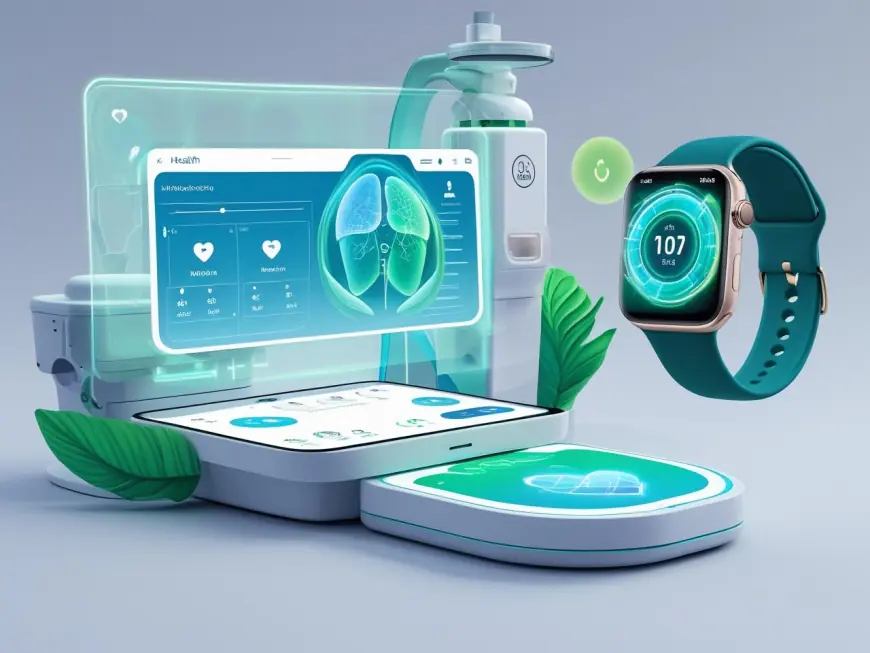The Rise of Wearable Health Tech: More Than Just Fitness Tracking
Wearable health technology has evolved far beyond fitness tracking to become a vital part of Digital Health Technology. Modern wearables can monitor heart rhythms, sleep patterns, oxygen levels, and blood sugar in real time, supporting early diagnosis and personalized care. Integrated with electronic health records and AI tools, these devices empower patients, improve clinical outcomes, and reduce healthcare costs. Despite challenges like data privacy, accuracy, and accessibility, wearable tech is shaping the future of proactive and connected healthcare.

In the past decade, Digital Health Technology has transformed from a niche innovation to a mainstream force in modern healthcare. At the heart of this transformation is the exponential growth of wearable health technology—smart devices worn on the body that go far beyond basic fitness tracking. Once limited to counting steps or calories, today’s wearables can monitor heart rhythms, detect sleep disorders, measure blood oxygen levels, and even alert users to early signs of illness.
The evolution of wearable health tech is revolutionizing how patients, doctors, and researchers interact with health data. It’s no longer just about fitness; it's about real-time, continuous, and preventive care that empowers individuals and supports clinical decision-making.
In this article, we’ll explore the rise of wearable health tech, its expanding role in healthcare, how it connects to digital health infrastructure, and the opportunities and challenges that come with it.
What Is Wearable Health Technology?
Wearable health technology refers to electronic devices that are worn on the body to collect, analyze, and transmit health-related data. These devices may come in various forms, including:
-
Smartwatches (e.g., Apple Watch, Samsung Galaxy Watch)
-
Fitness bands (e.g., Fitbit, Xiaomi Mi Band)
-
ECG monitors and heart rate sensors
-
Smart rings (e.g., Oura Ring)
-
Blood pressure monitors
-
Glucose monitors (e.g., continuous glucose monitors or CGMs)
-
Smart clothing and patches
-
Hearing aids and smart glasses
These wearables use sensors to continuously track physical and physiological parameters. The collected data is often synced with smartphones, cloud servers, and electronic health records (EHRs), contributing to the larger Digital Health Technology ecosystem.
From Fitness to Clinical Health Monitoring
While the first wave of wearables focused on fitness goals—step counts, calorie burn, and heart rate during workouts—modern wearables are entering the realm of medical-grade diagnostics and health management.
1. Cardiovascular Health Monitoring
Advanced wearables now offer ECG functionality, detecting irregular heart rhythms such as atrial fibrillation (AFib). These devices allow early intervention, potentially saving lives.
-
Example: The Apple Watch Series 8 can generate an ECG similar to a single-lead electrocardiogram and alert the user if it detects AFib.
2. Sleep Analysis
Sleep disorders like sleep apnea, insomnia, and restless leg syndrome affect millions but often go undiagnosed. Wearables analyze sleep duration, stages (light, deep, REM), and quality to help identify and manage these issues.
-
Example: The Oura Ring provides detailed sleep tracking and readiness scores, supporting mental and physical wellness.
3. Blood Oxygen and Respiratory Monitoring
Pulse oximeters are now integrated into wearables, useful in identifying conditions like COVID-19 or COPD exacerbations. Oxygen saturation (SpO2) is a critical health metric in respiratory care.
-
Example: Fitbit and Garmin devices now include SpO2 sensors for overnight oxygen monitoring.
4. Continuous Glucose Monitoring (CGM)
For diabetics, CGMs offer real-time blood sugar readings via small sensors attached to the body. These devices reduce the need for finger-prick tests and help patients manage their condition more effectively.
-
Example: Devices like the FreeStyle Libre or Dexcom G7 allow diabetics to track glucose levels in real time and share data with healthcare providers.
Integration with Digital Health Technology
Wearables are not standalone gadgets—they are key components of the broader Digital Health Technology framework. Their ability to collect continuous, real-time health data makes them indispensable in the movement toward personalized, preventive, and value-based care.
Key Integration Areas:
-
Electronic Health Records (EHRs): Data from wearables can be integrated into patient records, providing clinicians with a more complete picture.
-
Remote Patient Monitoring (RPM): Hospitals use wearable tech to monitor chronic patients at home, reducing hospital readmissions.
-
Telemedicine Platforms: During virtual visits, doctors can access data from wearables for more informed consultations.
-
AI and Predictive Analytics: Wearables feed data into AI systems that can detect patterns, anomalies, and potential risks before symptoms appear.
Benefits of Wearable Health Tech
1. Early Disease Detection
Wearables can pick up subtle changes in physiology that signal the onset of disease—often before the patient feels symptoms. This allows for proactive intervention.
2. Personalized Healthcare
By collecting continuous data, wearables enable tailored treatment plans based on the individual’s real-time needs, rather than broad clinical averages.
3. Patient Empowerment
Users become active participants in their own care. Access to real-time health metrics promotes healthier lifestyle decisions and better disease management.
4. Cost Reduction
Preventive care through early detection and reduced hospital visits can significantly cut healthcare costs, making care more efficient and scalable.
5. Improved Clinical Outcomes
Doctors can monitor patients between visits, track treatment effectiveness, and adjust medications based on actual data—leading to better results.
Challenges and Limitations
Despite their potential, wearable health technologies face several hurdles.
1. Data Privacy and Security
As with any Digital Health Technology, safeguarding personal health information is crucial. Wearables collect sensitive data, making them targets for cyberattacks.
-
Solution: Manufacturers must implement end-to-end encryption, secure cloud storage, and adhere to data protection laws like HIPAA and GDPR.
2. Accuracy and Reliability
Not all wearable devices meet clinical standards. Data inaccuracies can lead to false alarms or missed warnings.
-
Solution: Regulatory oversight and FDA approval processes must evolve to validate medical-grade wearables.
3. Interoperability
Many wearables are designed for consumer use and may not easily sync with EHR systems or other clinical platforms.
-
Solution: Adoption of interoperability standards such as HL7 FHIR can bridge gaps between consumer tech and healthcare infrastructure.
4. Digital Divide and Accessibility
Not all patients have access to or are comfortable using wearable technology, especially older adults or those in low-income settings.
-
Solution: Health equity initiatives should ensure wearable health tech is inclusive and affordable.
5. Information Overload
Clinicians may struggle to manage or interpret the vast amounts of data generated by wearables without the right tools.
-
Solution: AI-powered dashboards and intelligent filtering systems can help prioritize actionable insights.
Real-World Examples and Case Studies
-
Cleveland Clinic uses wearable ECG monitors to track heart health in at-risk patients remotely.
-
Stanford University conducted research showing wearables could predict infections like COVID-19 days before symptoms appear.
-
Kaiser Permanente integrates wearable data into its EHR system to enhance chronic disease management programs.
The Future of Wearable Health Tech
The future of wearable health tech is moving rapidly toward medical-grade diagnostics, AI integration, and continuous preventive care.
Key Trends to Watch:
-
Smart patches that monitor hydration, temperature, and drug levels
-
Wearables powered by biosensors and nanotech
-
AI-driven health assistants built into wearables
-
Integration with mental health tracking—mood, stress, and behavioral analytics
-
Insurance rewards programs for health metrics collected by wearables
As part of the expanding world of Digital Health Technology, wearables are transitioning from consumer gadgets to essential tools in modern medicine.
Conclusion
The rise of wearable health technology signals a powerful shift in healthcare delivery. These devices are doing far more than tracking steps or counting calories—they are helping to detect diseases early, personalize treatments, reduce costs, and improve patient outcomes. As Digital Health Technology continues to evolve, wearables will play a vital role in building a smarter, more proactive healthcare system.
However, to fully unlock their potential, challenges related to accuracy, privacy, and accessibility must be addressed. With innovation, regulation, and equitable deployment, wearable health tech will shape the future of medicine—one data point at a time.
What's Your Reaction?
 Like
0
Like
0
 Dislike
0
Dislike
0
 Love
0
Love
0
 Funny
0
Funny
0
 Angry
0
Angry
0
 Sad
0
Sad
0
 Wow
0
Wow
0
Related Posts
Varicose Veins Treatment to Improve Circulation and Com...
southflorida vascular Jan 9, 2026 0 29.2k
Best Dentist in Panchkula
vivekvksoft1 Jan 10, 2026 0 14.8k


















































